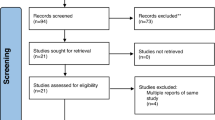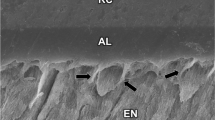Abstract
Purpose
To assess through a systematic review and meta-analysis of in vitro studies, the influence of the etching strategy (etch-and-rinse versus self-etch) of universal adhesive systems on bonding to primary teeth.
Methods
A systematic search was carried out in PubMed, Web of Science and Scopus. In vitro studies that compared the bond strength of the etching strategies of universal adhesives to primary teeth were included. Pooled-effect estimates were derived from a random-effects model by comparing the standardized mean difference between the etching strategies (α < 0.05). The risk of bias and heterogeneity between studies were also assessed (Cochrane and I2 tests).
Results
Seven studies were included in the review and six in the meta-analyses. For dentin, the immediate bond strength was not influenced by the etching strategy regardless of sound (Z = 0.72, p = 0.47) or caries-affected (Z = 1.27, p = 0.21) substrate, nor after aging (Z = 0.24, p = 0.81). It was not possible to perform a meta-analysis for the enamel substrate. Most studies have a medium risk of bias.
Conclusions
This systematic review and meta-analysis of in vitro studies provides evidence that universal adhesives can be used in both etching strategies in primary dentin. The evidence is currently insufficient about whether selective acid etching of primary enamel is necessary when universal adhesive systems are used.



Similar content being viewed by others
References
Angker L, Nockolds C, Swain MV, Kilpatrick N. Quantitative analysis of the mineral content of sound and carious primary dentine using BSE imaging. Arch Oral Biol. 2004;49:99–107.
Antoniazzi BF, Nicoloso GF, Lenzi TL, Soares FZ, Rocha RO. Selective acid etching improves the bond strength of universal adhesive to sound and demineralized enamel of primary teeth. J Adhes Dent. 2016;18:311–6.
Betancourt DE, Baldion PA, Castellanos JE. Resin-Dentin Bonding Interface: Mechanisms of degradation and strategies for stabilization of the hybrid layer. Int J Biomater. 2019;2019:5268342.
Cuevas-Suárez CE, da Rosa WLO, Lund RG, da Silva AF, Piva E. Bonding performance of universal adhesives: An updated systematic review and meta-analysis. J Adhes Dent. 2019;21(1):7–26.
de Goes MF, Shinohara MS, Freitas MS. Performance of a new one-step multi-mode adhesive on etched vs non-etched enamel on bond strength and interfacial morphology. J Adhes Dent. 2014;16:243–50.
Faggion CM Jr. Guidelines for reporting pre-clinical in vitro studies on dental materials. J Evid Based Dent Pract. 2012;12:182–9.
Fröhlich TT, Rocha RO, Botton G. Does previous application of silver diammine fluoride influence the bond strength of glass ionomer cement and adhesive systems to dentin? Systematic review and meta-analysis. Int J Paediatr Dent. 2020;30:85–95.
Ghajari MF, Ghasemi A, Badiee M, Abdolazimi Z, Baghban AA. Microshear bond strength of Scotchbond Universal Adhesive to primary and permanent dentin: a six-month in vitro study. Front Dent. 2019;16:173–80.
Hanabusa M, Mine A, Kuboki T, Momoi Y, Ende A, Meerbeek B, et al. Bonding effectiveness of a new ‘multi-mode’ adhesive to enamel and dentine. J Dent. 2012;40:475–84.
Higgins JPT, Thomas J, Chandler J, Cumpston M, Li T, Page MJ, Welch VA (editors). Cochrane Handbook for Systematic Reviews of Interventions version 6.1 (updated September 2020). Cochrane; 2020. www.training.cochrane.org/handbook.
Kim Y, Kim S, Jeong T, Son SA, Kim J. Effects of additional acid etching on the dentin bond strengths of one-step self-etch adhesives applied to primary teeth. J Esthet Restor Dent. 2017;29:110–7.
Lenzi TL, Gugliemi CAB, Arana-Chavez VE, Raggio DP. Tubule density and diameter in coronal dentin from primary and permanent human teeth. Microsc Microanal. 2013;19:1–5.
Lenzi TL, Raggio DP, Soares FZ, Rocha RO. Bonding performance of a multimode adhesive to artificially-induced caries-affected primary dentin. J Adhes Dent. 2015;17:125–31.
Lenzi TL, Gimenez T, Tedesco TK, Mendes FM, Rocha Rde O, Raggio DP. Adhesive systems for restoring primary teeth: a systematic review and meta-analysis of in vitro studies. Int J Paediatr Dent. 2016a;26:364–75.
Lenzi TL, Soares FZ, Raggio DP, Pereira GK, Rocha RO. Dry-bonding etch-and-rinse strategy improves bond longevity of a universal adhesive to sound and artificially-induced caries-affected primary dentin. J Adhes Dent. 2016b;18:475–82.
Lenzi TL, Soares FZM, de Oliveira RR. Does bonding approach influence the bond strength of universal adhesive to dentin of primary teeth? J Clin Pediatr Dent. 2017a;41:214–8.
Lenzi TL, Pires CW, Soares FZM, Raggio DP, Ardenghi TM, de Oliveira RR. Performance of universal adhesive in primary molars after selective removal of carious tissue: an 18-month randomized clinical trial. Pediatr Dent. 2017b;39:371–6.
Memarpour M, Shafiei F, Razmjouei F, Soltani M. Shear bond strength and scanning electron microscopy characteristics of universal adhesive in primary tooth dentin: an in vitro study. Dent Res J (isfahan). 2018;15:264–70.
Mendes LT, Loomans BAC, Opdam NJM, Silva CLD, Casagrande L, Lenzi TL. Silane coupling agents are beneficial for resin composite repair: a systematic review and meta-analysis of in vitro studies. J Adhes Dent. 2020;22:443–53.
Nicoloso GF, Antoniazzi BF, Lenzi TL, Soares FZ, Rocha RO. Is there a best protocol to optimize bond strength of a universal adhesive to artificially induced caries-affected primary or permanent dentin? J Adhes Dent. 2016;18:441–6.
Nör JE, Feigal RJ, Dennison JB, Edwards CA. Dentin bonding: SEM comparison of the resin-dentin interface in primary and permanent teeth. J Dent Res. 1996;75:1396–403.
Opdam N, van de Sande FH, Bronkhorst E, et al. Longevity of posterior composite restorations: a systematic review and meta-analysis. J Dent Res. 2014;93:943–9.
Page MJ, McKenzie JE, Bossuyt PM, et al. The PRISMA 2020 statement: an updated guideline for reporting systematic reviews. PLoS Med. 2021;18:e1003583.
Pashley DH, Tay FR, Breschi L, Tjaderhane L, Carvalho RM, Carrilho M, et al. State of the art etch-and-rinse adhesives. Dent Mater. 2011;27:1–16.
Pires CW, Soldera EB, Bonzanini LIL, et al. Is adhesive bond strength similar in primary and permanent teeth? A systematic review and meta-analysis. J Adhes Dent. 2018;20:87–97.
Salz U, Bock T. Testing adhesion of direct restoratives to dental hard tissue–a review. J Adhes Dent. 2010;12(5):343–71.
Sarkis-Onofre R, Skupien JA, Cenci MS, Moraes RR, Pereira-Cenci T. The role of resin cement on bond strength of glass-fiber posts luted into root canals: a systematic review and meta-analysis of in vitro studies. Oper Dent. 2014;39:E31-44.
Thanaratikul B, Santiwong B, Harnirattisai C. Self-etch or etch-and-rinse mode did not affect the microshear bond strength of a universal adhesive to primary dentin. Dent Mater J. 2016;35:174–9.
Tsujimoto A, Iwasa M, Shimamura Y, Murayama R, Takamizawa T, Miyazaki M. Enamel bonding of single-step self-etch adhesives: influence of surface energy characteristics. J Dent. 2010;38:123–30.
Van Meerbeek B, Peumans M, Poitevin A, et al. Relationship between bond-strength tests and clinical outcomes. Dent Mater. 2010;26:e100–21.
Acknowledgements
This study was financed in part by the Coordenação de Aperfeiçoamento de Pessoal de Nível Superior—Brasil (CAPES)—Finance Code 001.
Author information
Authors and Affiliations
Contributions
TTF conceived the idea and study design. TTF and ROR performed the literature search. TTF and LDG performed the extraction of data. TTF performed the meta-analysis and wrote the manuscript. LDG, FZMS and ROR contributed substantially to discussion and proofread the manuscript before its submission.
Corresponding author
Ethics declarations
Conflict of interests
The authors have no conflicts of interest to declare that are relevant to the content of this article.
Additional information
Publisher's Note
Springer Nature remains neutral with regard to jurisdictional claims in published maps and institutional affiliations.
Rights and permissions
About this article
Cite this article
Fröhlich, T.T., Gindri, L.D., Soares, F.Z.M. et al. Does the etching strategy influence the bonding of universal adhesive systems to primary teeth? A systematic review and meta-analysis of in vitro studies. Eur Arch Paediatr Dent 22, 1015–1022 (2021). https://doi.org/10.1007/s40368-021-00639-w
Received:
Accepted:
Published:
Issue Date:
DOI: https://doi.org/10.1007/s40368-021-00639-w




